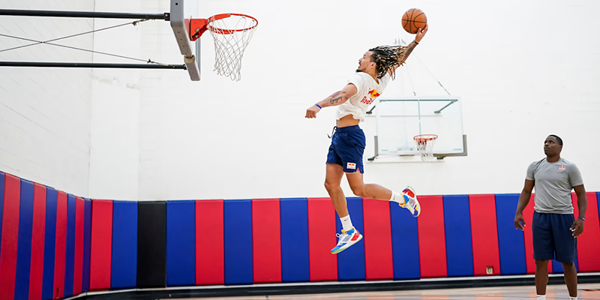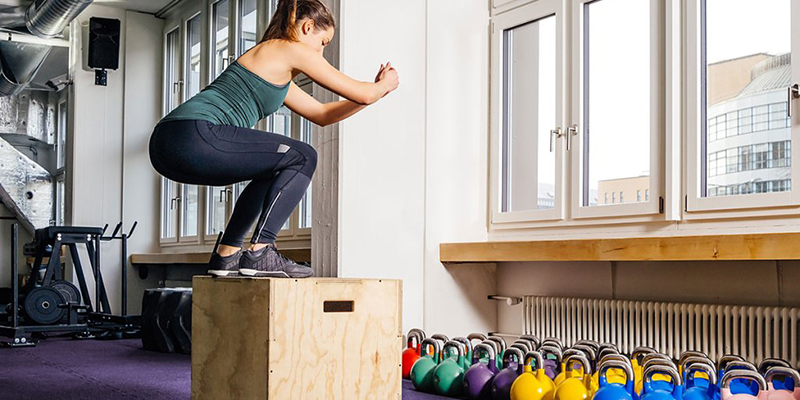Best Drills To Increase Vertical Jump In Basketball
Basketball values every detail and finesse, and a substantial vertical jump can differentiate between a game-winning dunk and losing the game entirely. Whether experienced in the sport or a beginner, enhancing your vertical jump will elevate your on-court capabilities and improve your overall athleticism.
Improving Your Vertical Jump
Increasing your vertical jump doesn't just involve leaping higher but blending multiple components such as strength, speed, balance, and technique. Simply put, the vertical jump is an explosive action that requires rapid force production in your core and legs. A strong vertical proves incredibly beneficial in basketball when rebounding, shot-blocking, and finishing at the hoop. Studies have found that plyometric exercises, which emphasize fast and powerful movements, can be used to develop this strength.

The quadriceps, hamstrings, glutes, and calves initiate the movement, working in synergy. Neuromuscular coordination allows for a powerful upward thrust. One will need to mix strength training with plyometrics to improve this skill.
Practical Exercises For Increasing Jump Height
When increasing jump height, no single strategy works for everyone. Each drill has its focus, meaning the results will be better if multiple drills are done within a routine. Below are drills that you can use:
Box Jumps
Box jumps are effective drills that promote leg power, so they dominate skill jump programs. When jumping onto a box, your muscles require energy to propel you upwards, enhancing your strength. A good technique is to master jumping on a low box before moving onto high boxes. This exercise not only develops leg strength but also increases balance and coordination.
Depth Jumps
Depth jumps are an advanced exercise that improves your training portfolio. In this exercise, you start by jumping off a box. Then, you land on the ground and immediately jump again. An eccentric landing and a concentric movement precede the jump. This movement trains your muscles to optimize their reaction speed, which is essential for any sporting activity. Control must be maintained during landing to avoid excessive impact. Proper form while landing is necessary.
Squat Jumps
Squat jumps are among the best exercises for increasing lower body strength and shocking power. The movement consists of starting in a squat and jumping off powerfully while extending your legs. The goal is to reach maximum height. After you land, make sure you brace for impact by going back into a squat. This drill focuses on taking maximum force from a stable position to explode. It is the one drill that combines strength training and explosive movements.
Tuck Jumps
Engaging your core and legs simultaneously. To perform tuck jumps, jump and bring your knees to your chest. During the landing of your jump, extend your legs to prepare for the next jump. While this exercise improves leaps, it also improves agility and coordination, essential basketball skills.
Calf Raises And Plyometric Variations
Although using explosive lower body moves seems appealing, don't forget your calves. The muscles on the lower leg, the calves, are a major contributor to a jump's final elevation. A more plyometric approach can be added by performing rapid calf raises, working both the lower leg and jumping. This produces strength in the calves and the quick, explosive movement required to enhance vertical jumps.
Lunge Jumps
Each leg can be worked on separately through lunge jumps, which develop unilateral strength. If you have any differences in the strength of your legs, this exercise can help you out. Begin in a lunge, then leap and switch your legs mid-air. You should land in a lunge position with the opposite leg in front. While performing lunge jumps, one improves one's stability and balance, which are necessary for controlling oneself during swift movements in a game.
Comparing The Drills: What Works Best For You?
The elements that define which combination of exercises is most effective for you depend on your fitness level, objectives, and even your style of play. You should look at the following differences and findings:
Explosive Power Vs. Strength Building:
Box jumps, and depth jumps, like other plyometric exercises, concentrate on powerful strength and neuromuscular coordination. They are ideal for athletes looking to increase their power and reaction times. Squat jumps and calf raises, on the other hand, increase strength by progressive means. Achieving all these can enhance a performer's ability to jump high. A vertical jump is now made through greater agility.

Unilateral Vs. Bilateral Training:
One leg is put to work in exercises such as lunge jumps, emphasizing strength on a single leg. Doing so can help correct any discrepancies in leg strength, which is essential for preventing injuries. Both legs are worked out simultaneously during bilateral exercises like squat jumps, and these, along with the other drills, are very beneficial for boosting overall strength. The most effective regimens tend to incorporate single and double-limb drills.
Impact On Balance And Coordination
Jumping onto a box and jumping with knees pulled to the chest, or tuck jumps, involves balancing and body control, so they are best suited for basketball players in the air who are ready to take a shot. Depth jumps are also suitable for basketball, as athletes use them to build power, but they require advanced coordination for proper and safe landing. Everybody has different strengths, and knowing those can help you partition workouts to suit your needs and focus on areas for improvement.
Training Smart: Implications And Insights
Keep the following pointers in mind while adding these drills to your personal training system:
Key Elements Should Be Focused On:
Muscles must be worked on regularly and adequately to perform vertical jumps efficiently. Two to three weekly training sessions are recommended, with breaks in between for muscle recovery. With the use of correct techniques and drills, long-term growth can be achieved.
Adherence To Technique And Correct Posture:
Acquiring great height can be achieved at the cost of injury, but it's imperative to maintain as much height as possible and correct posture while attempting box jumps or depth jumps. This will ensure that you do not injure yourself and assist in achieving maximum muscle output.
Mitigating Injury Risk & Muscle Recovery:
These exercises require a specific energy, meaning recovery is equally important. Incorporating foam rolling or Yoga days can keep muscles flexible while minimizing the risk of straining them.
Progression And Adaptation:
Begin at a level similar to what you can do now, then increase the challenge. For instance, start with lower boxes and a few repetitions before progressing to higher boxes or more explosive variations. This method allows the body to acclimatize without excessive Stress on the muscles, thus lowering recovery time and increasing efficiency in the long run.
Mind-Muscle Connection:
Understanding how muscles engage while drilling can go a long way. Attend to the jump and muscle release phase while vividly imagining a force coming from your legs and abs as you propel yourself up. This will increase the effectiveness of your drills and enhance your athletic performance as a whole.
Elevate Your Game
Challenging yourself with these drills will undoubtedly lead to greater on-the-court confidence, explosive movements, and increased performance. Embrace the journey, celebrate the small victories, and keep pushing your limits. Your next great leap is just around the corner.




